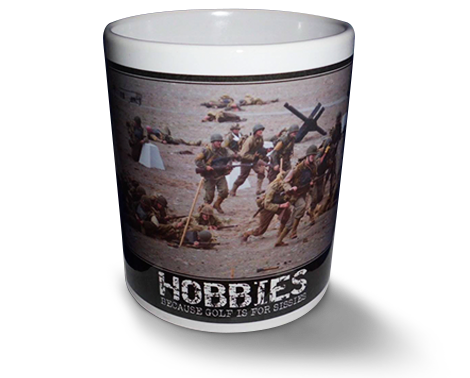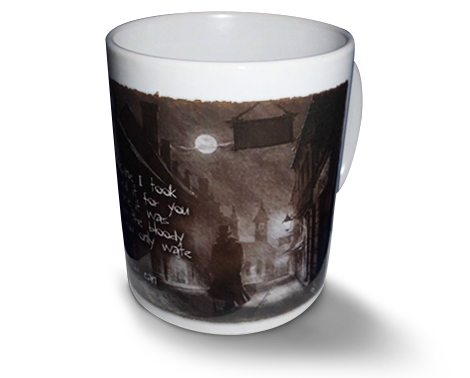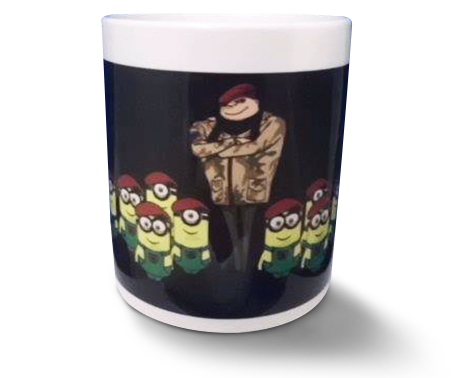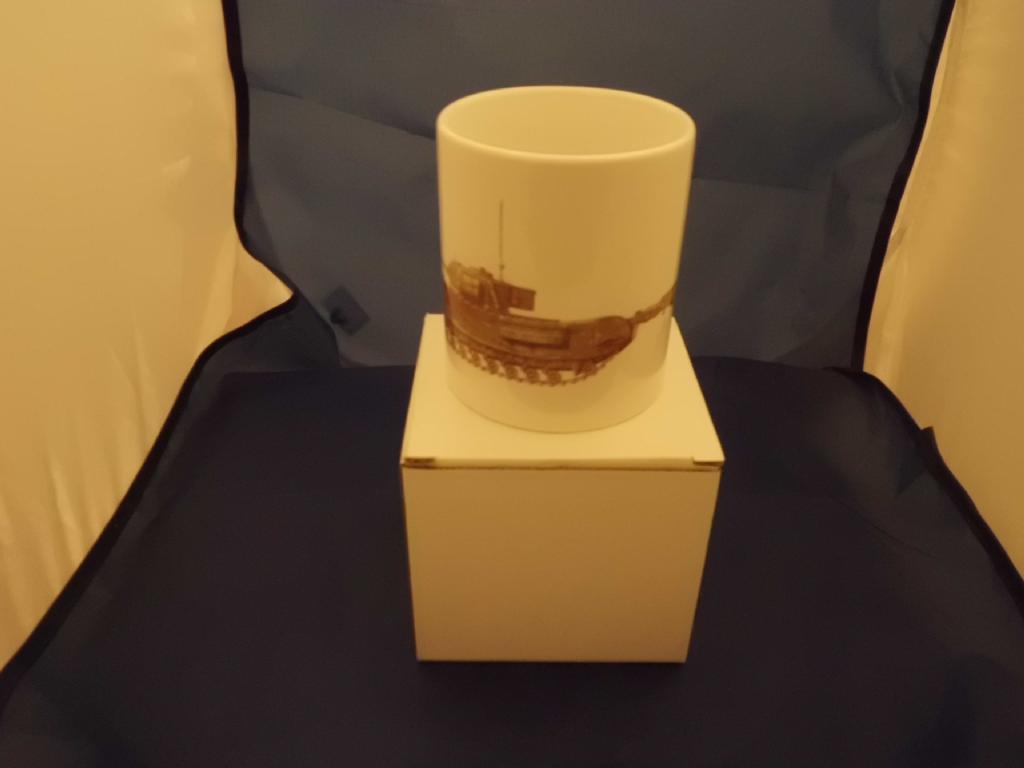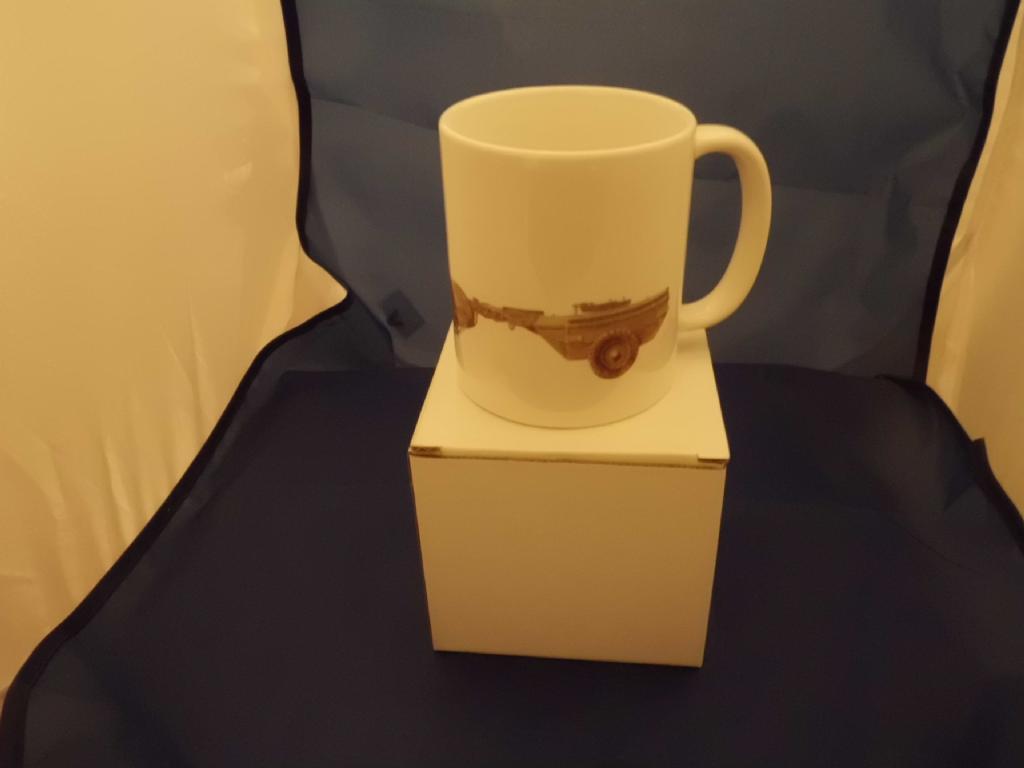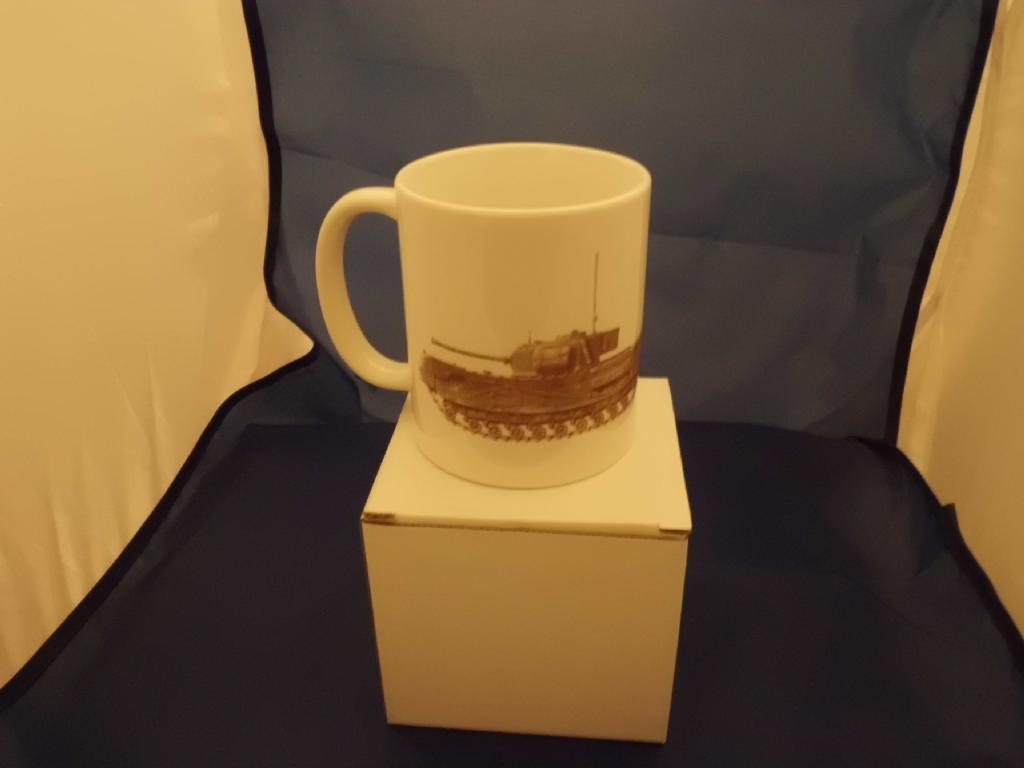Churchill Flamethrower Tank military Mug
11oz Mug
The mugs we use are top quality bright white, Orca coated, and are Dishwasher and Microwave safe, the high quality images are bonded into the surface of the mug, and do not fade or peel off like transfers
GREAT FOR GIFTS, BIRTHDAYS, OR JUST TO ADD TO YOUR MEMORABILIA COLLECTION.
The artwork is created in our offices/workshop, and we are available for custom work. These designs are individually made, not mass produced.
Please note that I take great care in packaging the mugs they are sent in a polystyrene mug box designed to specifically for posting mugs hence the postage costs
Hobart’s Funnies
Few Allied weapons struck fear into the hearts of the German infantrymen extra than the fearsome Churchill Crocodile. built at the chassis of the ever-dependable Churchill Infantry Tank, the Crocodile flamethrower was one of the maximum lethal weapons within the British army’s arsenal as they fought through Europe during the latter tiers of the second one world war.
The Crocodile is one of the maximum famous of ‘Hobart’s Funnies’, and served with the well-known 79th Armoured division.
A Crocodile demonstrates it is fiery breath
A Crocodile demonstrates it’s fiery breath
British Flamethrowing Tanks
for the duration of the early tiers of worldwide war 2, the British saw the flamethrower tank as a crucial weapon to defeat the expected fortifications of a Europe that would all over again be locked in a stalemated warfare. prior to the work on the adoption of the Churchill, various other motors were tested with flame gadget. those protected the frequent carrier, Valentine and even unarmored lorries.
the first strive at turning a Churchill into a flamethrower tank got here in 1942 in the shape of the Churchill Oke, named after predominant J. M. Oke who designed the conversion. previous to the approaching raid on Dieppe, primary J.M. Oke devised a flame-throwing change, implemented to a few prototype cars, named “Boar”, “Beetle” and “Bull”. A pipe apparatus, with the fuel tank fitted on the rear, become linked to the front left hull Ronson flame projector, leaving the right-hand facet hull machine-gun unobstructed. The Oke became only produced in constrained numbers before being outmoded by means of the Crocodile, although the three check motors have been part of the first wave at Dieppe.
Tintagel of the 48th Royal Tank Regiment outfitted out as an Oke. This tank become renamed Boar earlier than it went ashore at Dieppe with the Canadian 14th navy Tank Regiment. photo: Osprey Publishing
“Tintagel” of the forty eighth Royal Tank Regiment equipped out as an “Oke”. This tank became renamed Boar earlier than it went ashore at Dieppe with the Canadian 14th navy Tank Regiment. picture: Osprey Publishing
Preacher of fire and Brimstone
The Churchill Crocodile become one of the famous “Hobart’s Funnies”, named, of course, after most important wellknown Percy C. S. Hobart. along with the Petard Mortar armed AVRE, the Crocodile’s development changed into a surprisingly exclusive enterprise. so much in order that super lengths might be taken to break disabled Crocodiles within the discipline to prevent capture.
The Crocodile's flamethrower system. photograph: Haynes Publishing/Nigel Bernard Law Montgomery
The Crocodile’s flamethrower system – image: Haynes Publishing/Nigel 1st viscount montgomery of alamein
The Churchill chassis used become that of the Mk.VII A22F, although some early versions were primarily based at the Mk.IV. The A22Fs were especially built to be effortlessly convertible into Crocodiles. The tanks stored their fashionable weaponry. This covered the Ordnance short-Firing seventy five mm (2.95 in) gun and coaxial 7.ninety two mm (zero.31 in) BESA gadget gun. Crocodiles primarily based at the Mk.IV nonetheless carried the Ordnance brief-Firing 6-Pounder (fifty seven mm/2.24 in). Armor of as much as 152mm (five.ninety eight in) thick additionally remained. The major distinction from the unique motors, of course, turned into the flamethrower device.
‘The hyperlink’ at the back of the Cobbaton combat collection’s Churchill Crocodile. be aware the diverse articulated joints that allowed the trailer its wide range of motion, and the pipe that runs beneath the tank that carried the flame gasoline to the projector on the front of the tank. photo: Authors picture.
The flamethrowing nozzle turned into set up in region of the Churchill’s regular hull machine gun. A pipe ran from this thru a gap in the hull floor to a coupling on the rear of the car officially referred to as “The hyperlink”. attached to this became a wheeled trailer weighing 6.five lots with armor up to 12 mm (0.forty seven in) thick. “The link” turned into made of 3 articulated joints which allowed it to move up, down, left or proper and swivel on the horizontal axis to permit it to navigate rough terrain. The trailer carried four hundred gallons of flamethrower liquid and 5 compressed bottles of nitrogen (N₂) fuel and could be jettisoned from inside the tank.
the primary wave of vehicles changed into nearing of entirety by using October 1943. via the end of the production run, round 800 Crocodiles were built or converted to the standard.
Loading of the fuel trailer. The gas is poured in by hand on the left. The nitrogen fuel bottles are loaded into the rear at the right. photo: Osprey Publishing
Loading of the gasoline trailer. The fuel is poured in through hand at the left. The nitrogen gasoline bottles are loaded into the rear on the right -image: Osprey Publishing
Flame On
Following the depression of the cause, the nitrogen fuel could propel the flammable liquid via the piping and out of the nozzle at four gallons a 2d. The liquid became ignited via an electrical spark at the tip of the nozzle. The thrower should spray to a most distance of one hundred fifty yards (140 m), even though eighty yards (seventy five m) became more sensible in combat circumstances. The nitrogen would offer pressure for up to eighty one-2nd bursts. Longer bursts were elective. in addition to being lit on the nozzle, the liquid can be sprayed on “bloodless” after which ignited by way of a subsequent lit burst.
The Crocodile's flame projector. photo: Imperial battle Museum. H37937.
The Crocodile’s flame projector. photograph: Imperial war Museum. H37937.
Lieutenant Andrew Wilson, wrote an account of seeing an illustration of the Crocodile in September 1942:
“a touch burst of fireplace, like a struck match above the nozzle, examined the spark and the tank started to transport forward. It went closer to the first goal, a concrete pill-container. abruptly there has been speeding inside the air, a vicious hiss. From the front of the tank, a burning yellow rod shot out. Out and out it went, up and up with a noise just like the slapping a thick leather-based strap. The rod curved and began to drop, throwing off burning debris. It struck the concrete with a violent smack. A dozen yellow palms leapt out from the factor of impact attempting to find cracks and apertures. all at once the pillbox changed into engulfed in fireplace – belching, twisting pink-roaring hearth. And clouds of queer-smelling grey-black smoke. Then any other speeding. This time the rod went easy through an embrasure, smacking, belching, roaring. The flame shot out via the again of the pillbox, fanning like a blow-torch.”
Churchill Crocodile Stallion of A Squadron, 141st Regiment, Royal Armoured Corps (The Buffs, Royal East Kent Regiment). picture: Tauranga recollections
Churchill Crocodile “Stallion” of A Squadron, 141st Regiment, Royal Armoured Corps (The Buffs, Royal East Kent Regiment). image: Tauranga reminiscences
A Crocodile lies disabled amongst 2 M4 Shermans.
A Crocodile lies disabled among 2 M4 Shermans. The tanks, knocked out for the duration of the assault on Boulogne, are from the 3rd Canadian department – photo: 3rdweal of Reddit
WW2 carrier
The Crocodile saw huge carrier for the duration of the Allied push via Italy and North-West Europe. thirteenth Troop, C Squadron of the 141st Regiment Royal Armoured Corps (The Buffs, Royal East Kent Regiment) positioned their Crocodiles to bare on the first day of the Normandy invasion.
the 1st Fife and Forfar Yeomanry and the seventh Royal Tank Regiment used them as nicely. participants of the 7th RTR could famously have their photo taken on a Crocodile outside of the Bergen Belsen attention camp, which they helped to disencumber. Crocodiles would cross on to help the U.S. military in a number of engagements, together with on the Normandy bocage and the war for Brest. They would also fight alongside them in the Anglo-American assault on Geilenkirchen, referred to as “Operation Clipper”. Crocodiles supported the 53rd Welch department in their attack on s’Hertogenbosch inside the October of 1944. In Italy, the Crocodiles saw movement with the twenty fifth Armoured attack Brigade.
In those moves listed above, the Crocodile might frequently operate along with the Petard mortar-armed Churchill AVRE. more often than not, the psychological impact of the motors would be sufficient to overcome the foe. one can best imagine the dread felt with the aid of the Germans who were being stared down through the mortar of the AVRE and the flaming nozzle of the Crocodile.
whilst facing a stubborn enemy bunker or role, the Crocodile would lay a few flame in visible variety to show off its lethal breath. ought to the placement preserve to stand, the accompanying AVRE might crack it open with a mortar spherical. The Crocodile might then continue to cover the breached vicinity within the flaming liquid which could then flow into the placement.
Churchill Crocodile with blown off turret, Schilber, Limburg. photograph: 3rdweal of Reddit
The success of the Crocodile became also its curse. once the German military found out how to pick out a Crocodile, anti-tank fire changed into regularly focused on it. It became also now not unknown, and there is at least one recorded instance of this taking place, for crews of disabled Crocodiles to be completed on the spot as revenge for his or her assaults.
In 1944, as part of the Lend-hire program with the Soviet Union, 3 Crocodiles have been sent. it's far unknown whether these vehicles had been ever fielded via a combat unit, or what passed off to them after the war
submit conflict carrier
a few 250 Crocodiles have been earmarked for use inside the eastern theater towards the japanese. these maximum likely could’ve been used had the struggle not ended. In 1946, the Crocodile was examined at the hills of Chaklala in India to see how it would’ve achieved inside the eastern environment. even though the tank stored its wonderful move-usa and climbing competencies, the Crocodile turned into concept impractical because of its wheeled trailer.
Even after this although, the Crocodile saw service alongside the usual Churchill into the Korean war from 1950 till their withdrawal in 1951. They served with C Squadron within the seventh Royal Tank Regiment’s twenty ninth Brigade. Crocodiles had been officially eliminated from service no longer long after this.
Survivors
within the united kingdom, surviving Crocodiles can be found in some of locations. numerous are owned with the aid of the Muckleburgh series in Norfolk, the Cobbaton combat collection in Devon, Eden Camp Museum in North Yorkshire, the D-Day museum in Portsmouth, the Wheatcroft series, and, of route, The Tank Museum in Bovington. a few are also in the arms of private creditors.
a few can be observed somewhere else within the international as well. The Kubinka Tank Museum in Russia has one, the Museum of the Regiments, Calgary, Alberta Canada has another, with one more on the Royal Australian Armoured Corps Museum.
may be found in France, one without a trailer is on show on the Bayeux Museum of the battle of Normandy. A Crocodile talented to France through Queen Elizabeth II is displayed at the citadel Montbarey parade ground in Brest, Brittany.
The Churchill Crocodile on the Tank Museum, Bovington, England. photo: writer’s picture
The Churchill Crocodile on the Cobbaton fight Colection, North Devon, England. photo: writer’s image
an editorial by way of Mark Nash
Churchill Crocodile
Dimensions (not inclusive of trailer) 24’5” x 10’eight” x 8’2”
7.forty four x 3.25 x 2.49 m
total weight Approx. 40 tons + 6.five-ton trailer
crew five (motive force, bow-gunner, gunner, commander, loader)
Propulsion 350 hp Bedford horizontally opposed dual-six petrol engine
velocity (road) 15 mph (24 km/h)
Armament Ordnance QF seventy five mm (2.ninety five in) Tank Gun
BESA 7.ninety two mm (zero.31 in) device-gun
Flame Thrower
Armor From 25 to 152 mm (0.98-five.ninety eight in)
overall manufacturing ~ 800
sources
A recorded interview with Ernest Edward Cox, surviving group member of “Stallion”, the Crocodile pictured above. Interview through Jeena Reiter. read here.
Osprey Publishing, New forefront #7 Churchill Infantry Tank 1941-fifty one
Osprey Publishing, New vanguard #136 Churchill Crocodile Flamethrower
Haynes proprietors Workshop Manuals, Churchill Tank 1941-56 (all models). An perception into the records, development, manufacturing and function of the British army tank of the second world battle.
David Fletcher, Mr. Churchill’s Tank: The British Infantry Tank Mark IV, Schiffer Publishing
David Fletcher, leading edge of Victory: The 79th Armoured division, Her Majesty’s Stationery workplace

